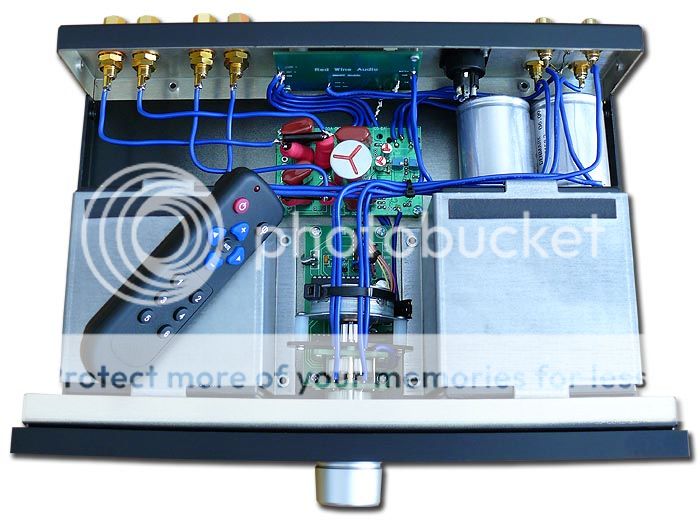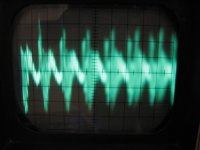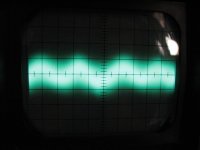Multiple ramblings and dumb questions
I ended up purchasing the Meanwell 27V PS--still waiting for it. Batteries were good, but I read so many raves about the higher-powered Meanwells that I just had give it a try.
New DAC is a Beresford TC-7520, which has definitely improved the digital side of my system. I might still get the VALAB DAC just because I'm curious about non-oversampling DACs. Oh yeah, I'm also a very happy owner of a babied one-owner Superphon Revelation Basic preamp. Am I the only one who interpreted the Sure board's DIP switch settings backasswards? I thought the "zero" settings for low gain meant, um, a resultant low gain instead of the opposite . . . Anyhow, I'll go for a medium gain setting since my volume control at nine o'clock is very loud.
Anyhow, I'll go for a medium gain setting since my volume control at nine o'clock is very loud.
Dumb questions alert: the input cap and the bypass cap are paralleled, correct? And won't it be ridiculous/redundant to use two foil caps versus an electrolytic/foil combo, since the 'lytic filters low freqs and the foil filters high freqs? Or should I just forgo the bypass?
dr_vega and ElFishi, I won't rest until I double the voltage. I gotta know for myself. I'll post impressions once I have a decent preamp in a couple of weeks. You would think 12 versus 24 volts would be definitive enough to draw a strong conclusion.
Can anybody suggest a decent transport? I'm probably going to get the Valab NOS DAC. Why did I ever get rid of my CAL?
I ended up purchasing the Meanwell 27V PS--still waiting for it. Batteries were good, but I read so many raves about the higher-powered Meanwells that I just had give it a try.
New DAC is a Beresford TC-7520, which has definitely improved the digital side of my system. I might still get the VALAB DAC just because I'm curious about non-oversampling DACs. Oh yeah, I'm also a very happy owner of a babied one-owner Superphon Revelation Basic preamp. Am I the only one who interpreted the Sure board's DIP switch settings backasswards? I thought the "zero" settings for low gain meant, um, a resultant low gain instead of the opposite . . .
Dumb questions alert: the input cap and the bypass cap are paralleled, correct? And won't it be ridiculous/redundant to use two foil caps versus an electrolytic/foil combo, since the 'lytic filters low freqs and the foil filters high freqs? Or should I just forgo the bypass?
I wonder what the scope pattern would look like with the power supply actually powering the amp at high listening volume and with the supply outputs left floating as in the poor example? Would the amp pull the negative supply leg to audio ground and stabilize it with out the need for the jumper? It would also be interesting to see if the music power demand can modulate the supply at all. The MeanWell supplies sound very stiff to me.
The effect is swamped by the switching noise of the amp feeding back (through almost 20mF, mind you) to the PSU. The first attached pictures shows the scope reading taken at the PSU output terminals with the amp powered but idle at 20mV/div and .5us/div. The second with a 85Hz signal at quite loud, 20mV/div 5ms/div. Both taken with the cap btn COM and Earth in place. If the cap is removed the result look slightly different, but the signal basically spans the same voltage.
Attachments
MeanWell ripple
So that's close to 40mv ripple? coming back from the 650kHz and almost as much from the 85Hz which would be the .012 seconds per cycle wave in the second shot. Doesn't look all that impressive but the MeanWell power supplies certainly sound great. You added an additional 20,000uF capacitance? I would have thought that would knock the 85Hz ripple down more than that.The effect is swamped by the switching noise of the amp feeding back (through almost 20mF, mind you) to the PSU. The first attached pictures shows the scope reading taken at the PSU output terminals with the amp powered but idle at 20mV/div and .5us/div. The second with a 85Hz signal at quite loud, 20mV/div 5ms/div. Both taken with the cap btn COM and Earth in place. If the cap is removed the result look slightly different, but the signal basically spans the same voltage.
So that's close to 40mv ripple? coming back from the 650kHz and almost as much from the 85Hz which would be the .012 seconds per cycle wave in the second shot. Doesn't look all that impressive but the MeanWell power supplies certainly sound great. You added an additional 20,000uF capacitance? I would have thought that would knock the 85Hz ripple down more than that.
I replaced the tank caps on board with 4 x 1800uF Pana FM and I have 3 x 3300uF Yageo low-ESR caps and a 0.39Ohm resistor btn board and PSU.
I was thinking of taking two of these 4x100 boards, and using 6 channels to bi-amp my front 3 speakers in my 5.1 system, single-amp the back 2 speakers. Then I could use two Mean Well 24V 350W amps... or a single 600W amp for power. Run Audyssey across it all to mop up levels. Subwoofer is self powered.
Its my first project. Would you go with a single power supply or dual (or even SLA?). Are there any components that are low hanging fruit to swap out on the Sure boards?
Its my first project. Would you go with a single power supply or dual (or even SLA?). Are there any components that are low hanging fruit to swap out on the Sure boards?
resistor
Wow! That is crazy that all that ripple, even a simple 85Hz tone, can walk right through all of that filtering especially with the resistor.I replaced the tank caps on board with 4 x 1800uF Pana FM and I have 3 x 3300uF Yageo low-ESR caps and a 0.39Ohm resistor btn board and PSU.
The power supplies are cheap
Might as well go for two 350watt power supplies as they are cheap.I was thinking of taking two of these 4x100 boards, and using 6 channels to bi-amp my front 3 speakers in my 5.1 system, single-amp the back 2 speakers. Then I could use two Mean Well 24V 350W amps... or a single 600W amp for power. Run Audyssey across it all to mop up levels. Subwoofer is self powered.
Its my first project. Would you go with a single power supply or dual (or even SLA?). Are there any components that are low hanging fruit to swap out on the Sure boards?
Good point, cheaper that way. I wonder why. Now, with two 350W power supplies, can or should I just wire the power supply outputs in parallel?Might as well go for two 350watt power supplies as they are cheap.
Last edited:
no way
No way. Also be fore warned that the 4*100 boards have been having failures. I am going to stick with the 2X100 boards for now.Good point, cheaper that way. I wonder why. Now, with two 350W power supplies, can or should I just wire the power supply outputs in parallel?
Done for now . . .
Turns out the DIP switches operate the way I expected they should in the first place: off-off-off-off is the lowest gain. I must have been confused by semantics in something I read elsewhere in the hundreds of postings on this thread.
I opted not to bother bypassing the input caps since I'm liking what I'm hearing with Dayton polypropylenes (2.2uF/250V) in place of the four stock caps. Panasonic 1000uF/50V on each power rail, since I want to limit loud power-on thumps. Zobel network with 10R/1W Vishay/Dale "flameproofs" and Dayton 0.01uF/400V caps at the output taps.
Sounds better: more extended and delicate high frequencies and tremendous transient response! This is sub-basic for some folks on this thread, but hopefully it might help somebody somewhere. I doubt I'll mod anything else, since I just want to listen to a lot of music now.
Hopefully the Meanwell PS will improve the sound further, though I'm already using a 15V/20A linear supply that provides some stiff rectification (ripple less than 5mV peak to peak, full load and low line). 27V should be interesting. These Sure amps are a fantastic value.
Turns out the DIP switches operate the way I expected they should in the first place: off-off-off-off is the lowest gain. I must have been confused by semantics in something I read elsewhere in the hundreds of postings on this thread.
I opted not to bother bypassing the input caps since I'm liking what I'm hearing with Dayton polypropylenes (2.2uF/250V) in place of the four stock caps. Panasonic 1000uF/50V on each power rail, since I want to limit loud power-on thumps. Zobel network with 10R/1W Vishay/Dale "flameproofs" and Dayton 0.01uF/400V caps at the output taps.
Sounds better: more extended and delicate high frequencies and tremendous transient response! This is sub-basic for some folks on this thread, but hopefully it might help somebody somewhere. I doubt I'll mod anything else, since I just want to listen to a lot of music now.
Hopefully the Meanwell PS will improve the sound further, though I'm already using a 15V/20A linear supply that provides some stiff rectification (ripple less than 5mV peak to peak, full load and low line). 27V should be interesting. These Sure amps are a fantastic value.
Fan never turns on
My power supply fan never turns on. The supply barely gets warmer than ambient.Can someone comment on the noise level of the fan of the 350W 24V Mean Well PSU?
Can someone comment on the noise level of the fan of the 350W 24V Mean Well PSU?
When it goes on, it's noisy! It doesn't activate very often and then only for a short time. More of a protection than anything else. These boards don't push them very far at all. If you were using the boards flat out it may be different.
Ensure all the vent holes are not blocked and when you mount it in another chassis (as you should for safety, seems a waste, if they had but an iec connector in them you wouldn't have to.
 ) vent the chassis well.
) vent the chassis well.Another option is to mount another fan on top of theirs and run it at a lower voltage if it becomes a pain.
Hope this helps.
Terry
No way. Also be fore warned that the 4*100 boards have been having failures. I am going to stick with the 2X100 boards for now.
Sure says on their website "This is an updated amplifier board which has been fully tested. All the problems and defects having existed originally have been solved. We have improved this product by adding a washer to ensure good insulating effect and no more shortcircuit will happen again. This product still reserves the good features, so you are assured to buy our products. We’re grateful for your support and suggestions." 4*100 watt @ 4ohm, TK2050 D-class Audio Amplifier Board_Audio Amplifier Boards_Audio Amplifier and other Audio Boards_RF and Audio, Video Equipments_Sure Electronics' Webstore
The failures Sendler refers to, are they happening even now that "All the problems and defects having existed originally have been solved. We have improved this product by adding a washer to ensure good insulating effect and no more shortcircuit will happen again." Is it just the 'old boards' that fail, and how to distinguish them, maybe by the washer?
Also wanted to point out that some of the Mean Well PSU product line are made in Taiwan, some are made in China. Leaving aside the fact that the Sure website lists Taiwan as "Province of China" on their ordering form, the Taiwan made PSU's should be more reliable, closer to Made in Japan than Made in China. Look for a photo of the PSU and you can usually read the sticker.
Phase of the ripple?
I would be curious to see the phase versus the speaker output on a B channel. Is it possible that the inductors in the power supply are pumping like a current source and actually boosting the voltage as demand from the signal modulates the positive rail? The patterns don't seem to jive with the sound improvement I get when changing my linear supply to the MeanWells. They are in a whole other league. Much faster and more dynamic sound.The effect is swamped by the switching noise of the amp feeding back (through almost 20mF, mind you) to the PSU. The first attached pictures shows the scope reading taken at the PSU output terminals with the amp powered but idle at 20mV/div and .5us/div. The second with a 85Hz signal at quite loud, 20mV/div 5ms/div. Both taken with the cap btn COM and Earth in place. If the cap is removed the result look slightly different, but the signal basically spans the same voltage.
I had one of the improved boards, it blew. Since that time further improvements have been made.
See http://www.diyaudio.com/forums/clas...0w-class-d-amplifier-board-7.html#post1969737 and http://www.diyaudio.com/forums/clas...0w-class-d-amplifier-board-7.html#post1970901 posts 62 and 67 by Audio 1st. Ignore my silly posts in between. I was trying hard.
Hopefully this will cure the failure rate.
Terry
See http://www.diyaudio.com/forums/clas...0w-class-d-amplifier-board-7.html#post1969737 and http://www.diyaudio.com/forums/clas...0w-class-d-amplifier-board-7.html#post1970901 posts 62 and 67 by Audio 1st. Ignore my silly posts in between. I was trying hard.
Hopefully this will cure the failure rate.
Terry
Last edited:
4*100 still iffy?
Sure has been trying and will stand behind their sales. I see some of the 4*100 users reporting failures of the improved board.
http://www.diyaudio.com/forums/clas...0w-class-d-amplifier-board-5.html#post1960183
As for the MeanWell supplies, I don't care where they are made. They sound AWESOME! And, I have yet to read about anyone having a problem with them.
Sure says on their website "This is an updated amplifier board which has been fully tested. All the problems and defects having existed originally have been solved. We have improved this product by adding a washer to ensure good insulating effect and no more shortcircuit will happen again. This product still reserves the good features, so you are assured to buy our products. We’re grateful for your support and suggestions." 4*100 watt @ 4ohm, TK2050 D-class Audio Amplifier Board_Audio Amplifier Boards_Audio Amplifier and other Audio Boards_RF and Audio, Video Equipments_Sure Electronics' Webstore
The failures Sendler refers to, are they happening even now that "All the problems and defects having existed originally have been solved. We have improved this product by adding a washer to ensure good insulating effect and no more shortcircuit will happen again." Is it just the 'old boards' that fail, and how to distinguish them, maybe by the washer?
Also wanted to point out that some of the Mean Well PSU product line are made in Taiwan, some are made in China. Leaving aside the fact that the Sure website lists Taiwan as "Province of China" on their ordering form, the Taiwan made PSU's should be more reliable, closer to Made in Japan than Made in China. Look for a photo of the PSU and you can usually read the sticker.
Sure has been trying and will stand behind their sales. I see some of the 4*100 users reporting failures of the improved board.
http://www.diyaudio.com/forums/clas...0w-class-d-amplifier-board-5.html#post1960183
As for the MeanWell supplies, I don't care where they are made. They sound AWESOME! And, I have yet to read about anyone having a problem with them.
Indeed two 350W MeanWell are cheaper than one 600W. Just wonder if the 600W MeanWell would sound better, would have a deeper reserve of current. Or how does SLA power sound, this Red Wine guy says SLA is the bees knees http://www.redwineaudio.com/about/why-sla Or, does it help to stick a big-*** capacitor on the power supply to have a reserve of amps for transients.As for the MeanWell supplies, I don't care where they are made. They sound AWESOME! And, I have yet to read about anyone having a problem with them.
Here for example is a design that uses two 12V SLA batteries. (and two capacitors, despite him saying in the interview they can foul up the sound.)
 This unit uses "2 x 12V, 5Ah Sealed Lead-Acid (SLA) connected in series (24V system) and for charger a 12V, 1000mA SLA “auto-charger”. Would be interesting to determine the exact spec of the battery and the capacitors.
This unit uses "2 x 12V, 5Ah Sealed Lead-Acid (SLA) connected in series (24V system) and for charger a 12V, 1000mA SLA “auto-charger”. Would be interesting to determine the exact spec of the battery and the capacitors.

- Status
- This old topic is closed. If you want to reopen this topic, contact a moderator using the "Report Post" button.
- Home
- Amplifiers
- Class D
- Sure Electronics New Tripath Board tc2000+tp2050

